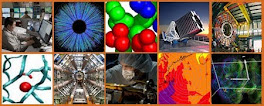One is invited to join the debate . Four of us bloggers are each given individual "home pages" on the website: Christina O, SabinaA, the recently-arrived Robert and myself.)
Whether, in the case of E.on, one calls it a public consultation exercise or a PR campaign, does not worry this blogger unduly. Given the way that the AGW debate has been politicized and polarized, any new forum is to be welcomed if it allows the voice of reason and real science to be heard without all the personal aggro.
 So this blogger has signed up, asking that any new forum be proactively moderated. I suggested in an email that it could usefully take a leaf from New Scientist about how to moderate. (For example, the NS has no time or patience for those persistent conspiracy theorists who clutter up its comments, and a good thing too.)
So this blogger has signed up, asking that any new forum be proactively moderated. I suggested in an email that it could usefully take a leaf from New Scientist about how to moderate. (For example, the NS has no time or patience for those persistent conspiracy theorists who clutter up its comments, and a good thing too.)I received an electronic galley proof of the Telegraph/Eon opening gambit, scheduled for
I'm not giving any secrets away by telling you that the central message of the exercise is that energy companies like E.on are confronted with what they call a "trilemma". (A parallel campaign on YouTube whence came my graphics is already underway with that questionable t-word neologism in prominence). The trilemma refers to so-called "conflicting" demands that future energy supplies be: 1. Green (low-carbon) 2. Affordable and 3. Reliable.
Well, one could be pedantic and say there's nothing conflicting there - they are merely three desirable criteria that need to be met simultaneously. Otherwise our lives would be burdened with trilemma, like where to live (it's got to be a nice area, affordable, handy for public transport).
Rather than nitpick, this blogger decided to focus on renewable energy, and how it might be made more reliable, given fluctuations in wind speed affecting turbine output etc. Clue: Dinorwig.
I'll let the Telegraph publish first, then wait a day or two.
Watch this space!
* Cruel Clever Cat by Geoffrey Taylor:
Sally, having swallowed cheese,
Directs down holes the scented breeze,
Enticing thus with baited breath
Nice mice to an untimely death.
Directs down holes the scented breeze,
Enticing thus with baited breath
Nice mice to an untimely death.
Additional reading E.on powers down to cut carbon and costs
Interesting to see the spotlight being put on our PCs - and rightly so, when you consider the heat that comes - not just from the laptop itself, but the charger too.
Energy-saving tip: when using one's laptop, switch off a light or other appliance that would normally be on, if it's superfluous to requirements when you are online.
Update: Thur 5th November: Here's a C&P of my first post on the E.on site. Having been up for a few days now, it would not seem a terrible breach of protocol to add it here for archival purposes:
Who can doubt that the future lies with renewable energy, and that we Brits are blessed with the stuff – existing or yet-to-be-realized.
First, there are those wind turbines – not the stuff of Wordsworthian rapture I grant you - but they are increasingly being sited offshore.
Then there’s solar energy, with a choice of two panels for your roof – the older thermal, or the state-of-the-art PV panels that can feed the electricity you don’t use into the National Grid.
And there’s wave power – which is a kind of secondhand solar power, recalling that weather and wind are due to unequal heating of the Earth’s surface.
And there’s even the dear old man in the moon, not wishing to be outshone by his flashy big brother, who contributes the prospect of tidal power. Just wait until we have a hydroelectric barrage across the Severn Estuary, supplying maybe as much as 10 per cent (?) of our power supply. (Yes, there are downsides, needless to say, to any big scheme, in terms of amenity, effect on wildlife, capital cost, the carbon-footprint of setting up etc. But let’s stick with the broad brush today.)
The problem with most of the renewable schemes is that the end-product – electricity, that energy-carrier par excellence – is generated at scattered locations across the country, supply may be intermittent, or supply may not match demand around the clock or calendar.
Is there a solution? Yes, there probably is, though it’s not always a panacea. One is talking about big money upfront, and, more to the point, big commitment.
But unless or until fusion power becomes a reality – which may take decades, centuries even – then there is no Plan B, assuming one is not a unbudgeable climate change denialist who thinks the world's scientists in their droves have abandoned all reason in condemning those fossil fuels.
So what is the solution? Simply go to the wiki page on Pumped Hydroelectric Storage, and it’s all there.
Britain already has 4 PHS stations – two in Scotland, two in Wales, and now needs a lot more in different shapes and sizes.
The principle is simple. One has two bodies of water – a lower and upper level. When there’s a surplus of electrical power, say from wind farms during the night, water is pumped from the lower to the upper level. When there’s extra demand, and the conventional stations are struggling to cope, water runs back through turbines, generating electricity.
It’s the closest one can get to “storing” electricity as the potential energy of a head of water. What’s more, the efficiency is surprisingly high – 80 per cent or more they claim in a well-designed system.
Do read the article, to see the new and imaginative ways of developing the principle. The Japanese have used the sea on Okinawa as one of the two levels, the other being a reservoir at the top of the headland.
The Danes have a plan that does not even need two levels – the water is simply pumped into a giant bladder which gradually plumps up, creating its own head. Sand is laid on top to get extra oomph.
My favourite is the salt-mine idea. We have lots of worked-out salt-mines in Cheshire and elsewhere. You pump water down into the old-workings, and site your upper reservoir on the surface. Yes, the water becomes brine, so all the equipment has to be corrosion-resistant. But there’s an upside too: once the water becomes saturated brine, it’s 20 per cent heavier than pure water, so becomes a more efficient energy-transfer medium.
What is it they say – where there’s a will, there’s a way!





















